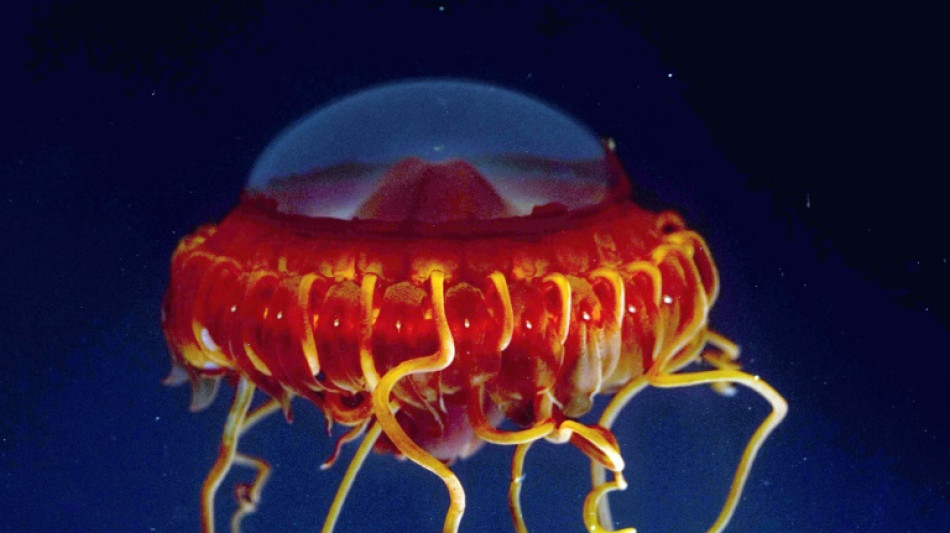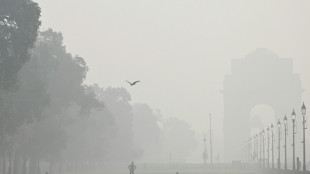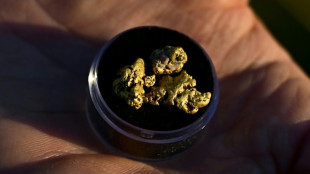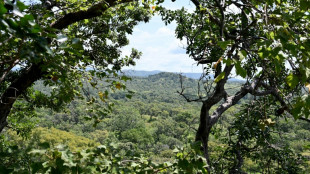
-
 India's cloud seeding trials 'costly spectacle'
India's cloud seeding trials 'costly spectacle'
-
Chiba wins women's title, Malinin leads at Skate Canada

-
 Siakam sparks injury-hit Pacers to season's first NBA win
Siakam sparks injury-hit Pacers to season's first NBA win
-
Denmark's fabled restaurant noma sells products to amateur cooks

-
 UK train stabbing wounds 10, two suspects arrested
UK train stabbing wounds 10, two suspects arrested
-
Nashville top Messi's Miami 2-1 to level MLS Cup playoff series

-
 Fergie, her daughters and the corgis hit by Andrew crisis
Fergie, her daughters and the corgis hit by Andrew crisis
-
'I can't eat': Millions risk losing food aid during US shutdown

-
 High price of gold inspires new rush in California
High price of gold inspires new rush in California
-
'Swing for the fences': Carney promises bold budget as US threat grows

-
 UK police arrest two after 'multiple people' stabbed on train
UK police arrest two after 'multiple people' stabbed on train
-
NBA Hawks lose guard Young for four weeks with knee sprain

-
 50 dead as Caribbean digs out from Hurricane Melissa
50 dead as Caribbean digs out from Hurricane Melissa
-
Forever Young gives Japan first Breeders' Cup Classic triumph

-
 Mbappe's Real Madrid extend Liga lead, Villarreal move second
Mbappe's Real Madrid extend Liga lead, Villarreal move second
-
Salah savours 'great feeling' after 250th Liverpool goal

-
 Ethical Diamond surges to upset win in $5 million Breeders' Cup Turf
Ethical Diamond surges to upset win in $5 million Breeders' Cup Turf
-
Kinghorn kicks Toulouse to Top 14 summit

-
 Mbappe extends Real Madrid's Liga lead in Valencia rout
Mbappe extends Real Madrid's Liga lead in Valencia rout
-
All Blacks sink 14-man Ireland 26-13 in Chicago Test

-
 World champ Malinin takes lead at Skate Canada
World champ Malinin takes lead at Skate Canada
-
Liverpool snap losing streak as Salah hits 250 goals in Villa win

-
 Salah's 250th Liverpool goal sinks Villa as Arsenal cruise at Burnley
Salah's 250th Liverpool goal sinks Villa as Arsenal cruise at Burnley
-
Morant suspended by Grizzlies after rebuking coaching staff

-
 Spalletti begins Juve tenure with win at Cremonese but Napoli held
Spalletti begins Juve tenure with win at Cremonese but Napoli held
-
Frank refuses to condemn Van de Ven, Spence for snub in Spurs defeat

-
 France superstar Dupont extends Toulouse deal
France superstar Dupont extends Toulouse deal
-
Egypt officially opens grand museum near pyramids

-
 French fraud watchdog reports Shein for 'childlike' sex dolls
French fraud watchdog reports Shein for 'childlike' sex dolls
-
Scotland thrash USA before All Blacks' clash

-
 Five things to know about the Grand Egyptian Museum
Five things to know about the Grand Egyptian Museum
-
Bayern rest stars but ease past Leverkusen before PSG clash

-
 Dead quiet: Paris Catacombs close for renovations
Dead quiet: Paris Catacombs close for renovations
-
Families separated, children killed as survivors flee Sudan's 'apocalyptic' El-Fasher

-
 Napoli held by Como as Spalletti begins Juve adventure
Napoli held by Como as Spalletti begins Juve adventure
-
Southampton boss Still vows to fight on as pressure mounts

-
 Borthwick hails 'ball of energy' Pollock as England down Australia
Borthwick hails 'ball of energy' Pollock as England down Australia
-
Egypt opens grand museum in lavish, pharaonic ceremony

-
 Joao Pedro strikes at last as Chelsea edge past Spurs
Joao Pedro strikes at last as Chelsea edge past Spurs
-
Ohtani to open for Dodgers in World Series deciding game seven

-
 Understrength Bayern sail past Leverkusen before PSG clash
Understrength Bayern sail past Leverkusen before PSG clash
-
Ramos header earns PSG late win over Nice

-
 Two more suspects including woman charged over Louvre heist
Two more suspects including woman charged over Louvre heist
-
Arteta hails Arsenal's 'exceptional' first half as leaders sink Burnley

-
 Two more suspects charged over Louvre heist
Two more suspects charged over Louvre heist
-
More than $2 mn in weapons seized in deadly Rio anti-drug raid: govt

-
 Feinberg-Mngomezulu guides South Africa to big win over Japan
Feinberg-Mngomezulu guides South Africa to big win over Japan
-
Sinner crushes Zverev to reach Paris Masters final, brink of No.1

-
 Pollock shines as England eventually overpower Australia
Pollock shines as England eventually overpower Australia
-
Villarreal crush Rayo to move second, Atletico beat Sevilla


Life in the abyss, a spectacular and fragile struggle for survival
Cloaked in darkness and mystery, the creatures of the deep oceans exist in a world of unlikely profusion, surviving on scant food and under pressure that would crush human lungs.
This extremely hostile environment, which will come under the spotlight at a major United Nations oceans summit in Lisbon this week, has caused its inhabitants to develop a prodigious array of alien characteristics and idiosyncratic survival techniques.
A vast assortment of animals populate the sunless depths, from the colossal squid, which wrapped its tentacles around the imaginations of sailors and storytellers, to beings with huge cloudy eyes, or whose bodies are as transparent as glass.
And the angler fish, with its devilish looks illuminated by a built-in headlamp, showing that the deep dark is alive with lights.
- 'Incredible' creatures -
Until the middle of the 19th century, scientists believed that life was impossible beyond a few hundred metres.
"They imagined that there was nothing, because of the absence of light, the pressure, the cold, and the lack of food," Nadine Le Bris, a professor at Sorbonne University, told AFP.
Between 200 and 1,000 metres (650 to 3,300 feet), the light fades until it vanishes completely, and with it plants; at 2,000 metres the pressure is 200 times that of the atmosphere.
From the abyssal plains to the cavernous trenches plunging deeper than Everest is high, aquatic existence continues in spectacular diversity.
"When people think of the deep sea they often think of the seafloor," said Karen Osborn of the Smithsonian's Natural History Museum.
"But all that water in between is full of incredible animals. There is a ton of life."
These open water inhabitants face a formidable challenge: they have nowhere to hide.
"There's no seaweed to hide in, no caves or mud to dig into," said Osborn.
"There are predators coming at them from below, from above, from all around."
- Masters of disguise -
One tactic is to become invisible.
Some creatures are red, making them difficult to distinguish in an environment where red light no longer filters through.
Others render themselves transparent.
Take the transparent gossamer worm, which ranges in size from a few millimetres to around a metre long and shimmies through the water by fluttering its frilly limbs.
"They look like a fern frond," said Osborn.
"They're beautiful animals and they shoot yellow bioluminescent light out of the tips of their arms. What could be better than that."
Bioluminescence is particularly common among fish, squid, and types of jellyfish, according to the US National Oceanic and Atmospheric Administration, which says around 80 percent of animals living between 200 and 1,000 metres produce their own light.
This chemical process might be helpful for defence, reproduction or to find food -- but no one knows for sure why so many creatures have evolved it, says NOAA.
- "Sea snow" -
With no plants around and animals scattered in the vastness doing their utmost to disappear, creatures in the ocean depths often have a hard time finding a live meal.
"If you happen to get lucky and hit a patch of your food, bingo! But you may not see another one for three weeks," said Osborn.
Another option is to feast on the dead.
Organic particles from the surface waters -- disintegrated bodies of animals and plants, mingling with fecal matter -- drift down in what is known as "marine snow".
This cadaverous confetti forms part of a process that sequesters carbon dioxide in the ocean depths.
It is also a lifeline for many deep sea animals, including the blood red vampire squid which, contrary to its reputation, peacefully hoovers up marine snow.
When giants like dead whales sink to the seabed, they are swiftly reduced to bone by scavengers.
- Final frontier -
With most of the oceans still unexplored, it is often said that we know more about the surface of Mars than we do about the seafloor on our own planet.
But unlike outer space, scientists keep finding life even under the most hostile of conditions.
Like the searing hydrothermal vents at the cracks between oceanic plates that spew chemical compounds such as hydrogen sulphide.
Microorganisms use this to create organic matter via "chemosynthesis", like plants use the sun for photosynthesis, which in turn feeds "exuberant" ecosystems, said Pierre-Marie Sarradin, head of the Deep Ecosystems department at the French research agency Ifremer.
These hydrothermal springs were totally unknown until the 1970s.
Scientists have so far identified some 250,000 marine species, though there could still be at least a million to be discovered.
Could there be an elusive sea monster lurking in the depths? Despite measuring more than 10 metres in length the colossal squid has only very rarely been seen.
"I don't think we're going to find a megalodon," said Osborn, referring to the giant ancestor of the shark.
Humans may not have explored much of the deep seas, but they have left their mark, via global heating, overfishing and pollution.
Oceans are acidifying as they absorb more and more CO2, there is a growing prevalence of "dead zones" without oxygen, while microplastics have been found in crustaceans at a depth of nearly 11 kilometres in the Mariana Trench.
Food reaches the bottom in smaller quantities.
Nadine Le Bris said species that "already live at the limits in terms of oxygen or temperature", are already "disturbed".
R.AbuNasser--SF-PST



